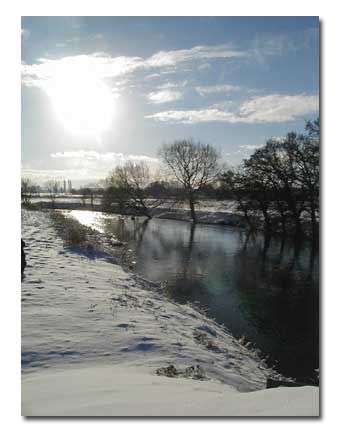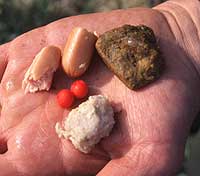|
|
| |
Dave will use heavy gear to fish for big barbel one day and a pole on ultra-light tackle the next to bag up on roach.
The emphasis on this series is how to enjoy your fishing no matter where you’re fishing or what you’re fishing for.
FLOODWATER SKILLS
Oh for the days when you could fish a river in autumn at normallevel with the water carrying just a hint of colour, guiding yourstick float down a steady glide beside the dying rush beds and see itdisappear to the bite of a quality roach sucking in your maggot hookbait. Unfortunately I think, due to our weather patterns havingaltered so much, these days are going to be far rarer than in thepast. Now, it seems, the rivers flood more often and much earlierthan maybe a decade or so ago, ripping out the summer weed growth andscouring the banks in the first few weeks of autumn.
|
|
| |
Given the weather of the last couple of weeks the earlyindications are that we are going to have another autumn and possiblywinter of higher than average rainfall. Already some areas of thecountry have had more rain in a day than normally falls in a month.If this proves to be the trend the obvious consequence is that riversare again going to spend a high proportion of their time running veryhigh and coloured. Hopefully they won’t be as bad as last year.
But there is a plus side
However, all is not lost, there is still pleasurable fishing to beenjoyed on a flooded river if you just learn how. The plus side isthat fish are still in the river and are coming in to primecondition. Despite people worrying about the ability of fish to copein horrendous flood conditions, the fact is they do and often theythrive. One of the benefits of floods is that a lot of food itemsget washed into the river from the bank side vegetation and througherosion of the soil and many species actually benefit from this,especially chub and barbel.
It is actually we anglers who cope far worse than the fish, as westruggle to come to terms with the extra water and the methods weneed to employ in order to tame the conditions. The thing toremember at all times is that the fish that were there in summer arestill there now, we just have to work out exactly where and employtactics that will catch them.
|
|
| |
Avoid the first floods
I have to say now that not all floods are worth fishing. Forinstance a rapidly rising river combined with falling water and airtemperatures is probably not going to produce too many fish, althoughnothing in fishing is guaranteed and exceptions will occur. I havealso found that the very first floods of the year that wash downloads of debris on the current are a waste of time, mostly becauseyou cannot achieve a good presentation with a ton of leaf litter onyour line that you have to remove every five minutes. However, catchthe river as it’s falling from it’s flood peak, especially if thetemperature is on the rise, and you could be in for a bonanza. Aneasy way to check whether the river is rising or falling is to inserta stick in the bank at water level when you arrive at the river andthen come back to it half an hour or so later and see if the waterlevel is above or below the stick. As for temperature trends, keepan eye on the weather patterns in the days prior to fishing andalways carry a thermometer, preferably one that can accuratelymeasure water temperature as well as air temperature.
Look for the obstructions and deeper areas
So, the next question to answer is, given the water level and itsadditional pace, where are the fish likely to be? Well, like wehumans, fish do like to be as comfortable as conditions allow. Theywon’t be in swims where the water is boiling and turbulent. Theywill seek out and congregate in areas where the flow is smooth andslower than the general pace of the river, so we should be lookingfor areas that have an even river bed that has had the pace sloweddown by an upstream obstruction.
|
|
| |
Now these obstructions can be anything and are quite likely to bethings that are not even usually in the river when at normal level. For instance, bankside trees and bushes that are normally above thewater line but are in the water during a flood will provide a brakeon the water flow. Here you can often find a shoal of roachsheltering from the full force of the main current. Alternatively,look for midstream obstructions. For instance rush beds, before theydie away completely, will cause the main current to flow either side,leaving a more sedate area immediately behind them. Employingupstream leger tactics into such an area will often catch chub andbarbel. The key though is to always look for an even flow. Itreally helps to have an intimate knowledge of the river in summer,knowing where the river bed undulates and where underwaterobstructions are. Not only can it give you clues where to look forholding swims, but it can also save you from casting into a promisinglooking area only to encounter a snag and lose some tackle.
Other than obvious obstructions, another good swim would be wheredeep water occurs between two shallower areas, especially if this isclose to the bank. In any current the water actually flows slowernearer the river bed than it does on the surface. Couple this with anatural depression in the river bed and what on the surface lookslike a torrent may well have a much slower flowing undercurrent.
|
|
| |
The advantages of upstream legering
I mentioned earlier upstream legering, which is a really effectivemethod in fast flowing water, but not many people use it, although inprinciple it is quite simple. Most people, I think, get put offusing the method because you need to get it just right with a’critically balanced’ rig. What I mean by this is that you need touse just enough lead to hold bottom, which may, by the way, be up to,or even more than, four ounces, but not so much that a bite from afish fails to move the lead. What you want to achieve is the lead inposition, a good bend in your quiver tip, but the lead able to bemoved by a fish applying only a little more pressure to the lead asit moves away with your bait. The movement of the lead causes theline to slacken and the quiver tip to spring back, known as a’drop-back’ bite. Put on too little lead and you won’t hold bottom. Put on too much and the fish won’t be able to shift the lead easily,preventing good bite detection.
Another benefit of upstreaming and drop-backs is that most bitesare self hooking, the weight of the lead pulling the hook home as itshifts downstream. Obviously to employ upstream tactics you need touse gear that is capable of casting big leads and a terminal rig thatallows a quick lead change.
And the right bait is very important
|
|
| |
Last, but certainly not least, is knowing what bait to use. Ithink that in floodwater smell plays a very important part in fishlocating a bait. And with loose feeding being very difficult I tendto use bigger single hook baits rather than smaller baits likemaggots. Cheese paste, lobworms and meat are the obvious ones andwill always catch fish, although this autumn I shall continue to useboilies and special pastes too, as I believe they will also continueto catch due to their high smell attraction properties and must beworth a go. Don’t overlook simple bread though, especially on afalling river, where the colour is beginning to drop out of thewater, as it is often the most deadly bait around for chub androach.
Remember, just because there is a bit of water on is no reason whyfish cannot be caught. I fully intend to keep after those river fishdespite the conditions and enjoy every minute of it.
















